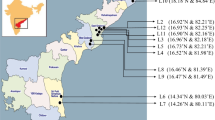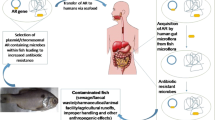Abstract
A basic understanding of abundance and diversity of antibiotic-resistant microbes and their genetic determinants is necessary for finding a way to prevent and control the spread of antibiotic resistance. For this purpose, chloramphenicol and multiple antibiotic-resistant bacteria were screened from a mariculture farm in northern China. Both sea cucumber and sea urchin rearing ponds were populated with abundant antibiotic-resistant bacteria, especially marine vibrios. Sixty-five percent chloramphenicol-resistant isolates from sea cucumber harbored a cat gene, either cat IV or cat II, whereas 35% sea urchin isolates harbored a cat gene, actually cat II. The predominant resistance determinant cat IV gene mainly occurred in isolates related to Vibrio tasmaniensis or Pseudoalteromonas atlantica, and the cat II gene mainly occurred in Vibrio splendidus-like isolates. All the cat-positive isolates also harbored one or two of the tet genes, tet(D), tet(B), or tet(A). As no chloramphenicol-related antibiotic was ever used, coselection of the cat genes by other antibiotics, especially oxytetracycline, might be the cause of the high incidence of cat genes in the mariculture farm studied.



Similar content being viewed by others
References
Agerso, Y, Guardabassi, L (2005) Identification of Tet 39, a novel class of tetracycline resistance determinant in Acinetobacter spp. of environmental and clinical origin. J Antimicrob Chemother 55: 566–569
Altschul, SF, Madden, TL, Schäffer, AA, Zhang, JH, Zhang, Z, Miller, W, Lipman, DJ (1997) Gapped BLAST and PSI-BLAST: a new generation of protein database search programs. Nucleic Acids Res 25: 3389–3402
Aoki, T (2000) Transferable drug resistance plasmids in fish-pathogenic bacteria. In: Arthur, JR, Lavilla-Pitogo, CR, Subasinghe, RP (Eds.) Use of Chemicals in Aquaculture in Asia, SEAFDEC Aquaculture Department, Tigbauan, Iloilo, Philippines, pp 31–33
Balebona, MC, Zorilla, I, Morinigo, MA, Borrego, JJ (1998) Survey of bacterial pathologies affecting farmed gilt-head sea bream (Sparus aurata L.) in southwestern Spain. Aquaculture 166: 19–35
Chen, J (2004) Present status and prospects of sea cucumber industry in China. In: Lovatelli, A, Conand, C, Purcell, S, Uthicke, S, Hamel, J, Mercier, A (Eds.) Advances in Sea Cucumber Aquaculture and Management, FAO Fisheries Technical Paper, No. 463, FAO, Rome, Italy, pp 25–38
Chopra, I, Roberts, M (2001) Tetracycline antibiotics: mode of action, applications, molecular biology, and epidemiology of bacterial resistance. Microbiol Mol Biol Rev 65: 232–260
Courvalin, P, Trieu-Cuot, P (2001) Minimizing potential resistance: the molecular view. Clin Infect Dis 33: S138–S146
Dang, H, Lovell, CR (2000) Bacterial primary colonization and early succession on surfaces in marine waters as determined by amplified rRNA gene restriction analysis and sequence analysis of 16S rRNA genes. Appl Environ Microbiol 66: 467–475
Dang, H, Zhang, X, Song, L, Chang, Y, Yang, G (2006) Molecular characterizations of oxytetracycline resistant bacteria and their resistance genes from mariculture waters of China. Mar Poll Bull (in press)
De Medici, D, Croci, L, Delibato, E, Di Pasquale, S, Filetici, E, Toti, L (2003) Evaluation of DNA extraction methods for use in combination with SYBR green I real-time PCR to detect Salmonella enterica serotype enteritidis in poultry. Appl Environ Microbiol 69: 3456–3461
Doroudgar, S (2005) Intimate association of Vibrio splendidus with the purple sea urchin Strongylocentrotus purpuratus. Saltman Q 2: 41–44
Felsenstein, J (1989) PHYLIP—Phylogeny Inference Package (Version 3.2). Cladistics 5: 164–166
Gay, M, Renault, T, Pons, AM, Le Roux, F (2004) Two Vibrio splendidus related strains collaborate to kill Crassostrea gigas: taxonomy and host alterations. Dis Aquat Org 62: 65–74
Gomez-Leon, J, Villamil, L, Lemos, ML, Novoa, B, Figueras, A (2005) Isolation of Vibrio alginolyticus and Vibrio splendidus from aquacultured carpet shell clam (Ruditapes decussatus) larvae associated with mass mortalities. Appl Environ Microbiol 71: 98–104
Jia, JS, Chen, JX (2001) Sea farming and sea ranching in China. FAO Fisheries Technical Paper, No. 418. FAO, Rome, Italy
Jun, LJ, Jeong, JB, Huh, MD, Chung, JK, Choi, DL, Lee, CH, Jeong, HD (2004) Detection of tetracycline-resistance determinants by multiplex polymerase chain reaction in Edwardsiella tarda isolated from fish farms in Korea. Aquaculture 240: 89–100
Keesing, JK, Hall, KC (1998) Review of harvests and status of world sea urchin fisheries points to opportunities for aquaculture. J Shellfish Res 17: 1597–1604
Kummerer, K (2004) Resistance in the environment. J Antimicrob Chemother 54: 311–320
Levy, SB (1992) The Antibiotic Paradox: How Miracle Drugs are Destroying the Miracle. Plenum Press, New York, NY
Li, T, Xu, S, Wang, R, Xu, S, Su, X (2000) Preliminary studies on the black mouth disease of sea urchin, Strongylocentrotus intermedius (Strongylocentrotidae Echinoidea). Mar Sci 24: 41–43 (in Chinese)
McCallum, H, Harvell, D, Dobson, A (2003) Rates of spread of marine pathogens. Ecol Lett 6: 1062–1067
Miranda, CD, Rojas, R (1996) Vibriosis in the flounder Paralichthys adspersus (Steindachner, 1867) in captivity. Rev Biol Mar 31: 1–9
Muroga, K (2001) Viral and bacterial diseases of marine fish and shellfish in Japanese hatcheries. Aquaculture 202: 23–44
Nealson, KH, Wimpee, B, Wimpee, C (1993) Identification of Vibrio splendidus as a member of the planktonic luminous bacteria from the Persian Gulf and Kuwait region with luxA probes. Appl Environ Microbiol 59: 2684–2689
Nelson, EJ, Ghiorse, WC (1999) Isolation and identification of Pseudoalteromonas piscicida strain Cura-d associated with diseased damselfish (Pomacentridae) eggs. J Fish Dis 22: 253–260
Padilla, C, Lobos, O, Brevis, P, Abaca, P, Hubert, E (2004) In vitro antibacterial activity of the peptide PsVP-10 against antimicrobial-resistant Enterococcus faecalis isolated from clinical samples. J Antimicrob Chemother 53: 390–392
Prayitno, SB, Latchford, JW (1995) Experimental infections of crustaceans with luminous bacteria related to Photobacterium and Vibrio spp. effect of salinity and pH on infectiosity. Aquaculture 132: 105–112
Roberts, MC (2005) Update on acquired tetracycline resistance genes. FEMS Microbiol Lett 245: 195–203
Sugumar, G, Nakai, T, Hirata, Y, Matsubara, D, Muroga, K (1998) Vibrio splendidus biovar II as the causative agent of bacillary necrosis of Japanese oyster Crassostrea gigas larvae. Dis Aquat Org 33: 111–118
Tantillo, GM, Fontanarosa, M, Di Pinto, A, Musti, M (2004) Updated perspectives on emerging vibrios associated with human infections. Lett Appl Microbiol 39: 117–126
Thompson, JR, Gibson, TJ, Plewniak, F, Jeanmougin, F, Higgins, DG (1997) The ClustalX windows interface: flexible strategies for multiple sequence alignment aided by quality analysis tools. Nucleic Acids Res 24: 4876–4882
Thompson, JR, Pacocha, S, Pharino, C, Klepac-Ceraj, V, Hunt, DE, Benoit, J, Sarma-Rupavtarm, R, Distel, DL, Polz, MF (2005) Genotypic diversity within a natural coastal bacterioplankton population. Science 307: 1311–1313
Thomson, R, Macpherson, HL, Riaza, A, Birkbeck, TH (2005) Vibrio splendidus biotype 1 as a cause of mortalities in hatchery-reared larval turbot, Scophthalmus maximus (L.). J Appl Microbiol 99: 243–250
Urakawa, H, Kita-Tsukamoto, K, Ohwada, K (1999) 16S rDNA restriction fragment length polymorphism analysis of psychrotrophic vibrios from Japanese coastal water. Can J Microbiol 45: 1001–1007
Wang, B, Li, Y, Li, X, Qu, J, Zhao, X (2005) Pathogenic mechanism of the causative vibrio found in “red spotting” diseased sea urchin Strongylocentrotus intermedius. J Dalian Fish Univ 20: 11–15 (in Chinese)
Wang, Y, Zhang, C, Rong, X, Chen, J, Shi, C (2004) Diseases of cultured sea cucumber, Apostichopus japonicus, in China. In: Lovatelli, A, Conand, C, Purcell, S, Uthicke, S, Hamel, J, Mercier, A (Eds.) Advances in Sea Cucumber Aquaculture and Management, FAO Fisheries Technical Paper, No. 463, FAO, Rome, Italy, pp 297–310
Wang, ZC, Chang, YQ (1997) Research prospects for mariculture of sea urchin. Mar Sci 2: 22–24 (in Chinese)
Wright, JG, Tengelsen, LA, Smith, KE, Bender, JB, Frank, RK, Grendon, JH, Rice, DH, Thiessen, AM, Gilbertson, CJ, Sivapalasingam, S, Barrett, TJ, Besser, TE, Hancock, DD, Angulo, FJ (2005) Multidrug-resistant Salmonella typhimurium in four animal facilities. Emerg Infect Dis 11: 1235–1241
Yoo, MH, Huh, MD, Kim, EH, Lee, HH, Jeong, HD (2003) Characterization of chloramphenicol acetyltransferase gene by multiplex polymerase chain reaction in multidrug-resistant strains isolated from aquatic environments. Aquaculture 217: 11–21
Acknowledgments
The authors would like to express our appreciation to the anonymous reviewers. With the kind critiques and suggestions from reviewer 1, our manuscript was improved greatly in both scientific accuracy and writing style. This work was financially supported by the National Natural Science Foundation of China grants (NSFC grant nos. 40476058 and 40576069), the Pilot Projects of Knowledge Innovation Project of Chinese Academy of Sciences grants (CAS grant nos. KZCX3-SW-223 and KZCX3-SW-233), and the grant from Institute of Oceanology, Chinese Academy of Sciences (IOCAS grant no. LSC2-3-1).
Author information
Authors and Affiliations
Corresponding author
Rights and permissions
About this article
Cite this article
Dang, H., Song, L., Chen, M. et al. Concurrence of cat and tet Genes in Multiple Antibiotic-Resistant Bacteria Isolated from a Sea Cucumber and Sea Urchin Mariculture Farm in China. Microb Ecol 52, 634–643 (2006). https://doi.org/10.1007/s00248-006-9091-3
Received:
Accepted:
Published:
Issue Date:
DOI: https://doi.org/10.1007/s00248-006-9091-3




